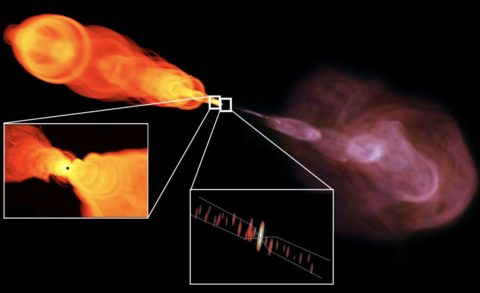Jets remain a mystery

FAU involved in DFG research group focusing on plasma rays from black holes.
A new DFG research group led by Julius-Maximilians-Universität Würzburg (JMU) is investigating ultra-high energy jets. Two astrophysicists from FAU are also involved. The research group will be funded with a total of 3.6 million euros over the next four years.
Black holes can be found in the centre of nearly all galaxies. They have an unimaginably large mass and attract material, gas and even light as a result. Just recently, astronomical images showing the accumulation of material on a super-massive black hole caused a stir among the general public.
Black holes like this can release immense energy out into their surroundings, energy which was originally stored in their rotation or the potential energy of collected material. Energy is released in jets. Jets are bundles of plasma rays which accelerate particles to tremendous energies before propelling them from the centre of the galaxy at speeds nearing the speed of light. Such jets can reach several hundred thousand light years into space and radiate bright radio, gamma and X-rays.
A number of mysteries remain
However, these jets still baffle researchers. What are they made of? How are they launched from the direct vicinity of supermassive black holes? Which processes are responsible for their high-energy radiation and how do they interact with the mother galaxy? These are the questions the new DFG research group ‘Relativistic Jets in Active Galaxies’ hopes to answer.
The German Research Foundation (DFG) is funding the project with 3.6 million euros over the next four years, with the option to continue into a second phase of funding lasting another four years. The speaker of the group is the astrophysicist Professor Dr. Matthias Kadler from JMU. Dr. Thomas Dauser and Prof. Dr. Jörn Wilms from Dr. Karl Remeis observatory, the Astronomical Institute at FAU, are also involved. Further projects are located at the universities of Hamburg and Heidelberg, the Leibnitz Institute for Astrophysics Potsdam and the Max Planck Institutes for Astronomy and Radio Astronomy in Heidelberg and Bonn.
Improving the combination of observations and modelling
The researchers have set themselves the ambitious goal of designing a model of the jets that can explain the physics behind the phenomenon and that fits in with all observations. In order to do so, they plan to overcome the traditional split between various scientific approaches to the problem, for example by coordinating observations and theoretical modelling to a much greater extent than is currently the case.
‘Impressive breakthroughs in observational astronomy and astroparticle physics in recent years have shifted the focus of modern research onto jets even more than before,’ explains Prof. Dr. Matthias Kadler. ‘At the same time, theoretical and numerical modelling have made enormous advances.’ Our research group is the first to combine these approaches in this way and to such an extent.’
Dr. Thomas Dauser explains, ‘In the FAU sub-project we will combine measurements in the X-ray range with satellites and measurements in the radio range in order to study the structure of the region directly around the black hole, in which jets are created.’
Prof. Wilms emphasises: ‘In this project, the research group effectively combines the existing expertise of the universities in Erlangen-Nuremberg and Würzburg when it comes to investigating black holes and their jets in the entire electromagnetic spectrum.’
Funding focused on supporting young researchers
DFG research groups are intended to enable researchers to focus on current and current questions in their field of research and to establish innovative areas of research. The funds provided by DFG ought to be largely used to create project positions for young researchers.
Further information
Professor Jörn Wilms
Dr. Karl Remeis Observatory Bamberg, Astronomical Institute of FAU.
Phone: +49 9131 95222 13